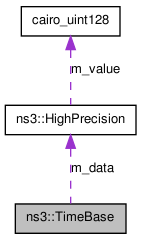keep track of global simulation resolution More...
#include <time-base.h>

Classes | |
| struct | Information |
| struct | Resolution |
Public Types | |
| enum | Unit { S = 0, MS = 1, US = 2, NS = 3, PS = 4, FS = 5, LAST = 6 } |
Public Member Functions | |
| TimeBase (const TimeBase &o) | |
| TimeBase | operator= (const TimeBase &o) |
| TimeBase (const HighPrecision &data) | |
| bool | IsZero (void) const |
| bool | IsNegative (void) const |
| bool | IsPositive (void) const |
| bool | IsStrictlyNegative (void) const |
| bool | IsStrictlyPositive (void) const |
| HighPrecision const & | GetHighPrecision (void) const |
| HighPrecision * | PeekHighPrecision (void) |
Static Public Member Functions | |
| static void | SetResolution (enum Unit resolution) |
| static enum Unit | GetResolution (void) |
| static TimeBase | FromInteger (uint64_t value, enum Unit timeUnit) |
| static TimeBase | FromDouble (double value, enum Unit timeUnit) |
| static uint64_t | ToInteger (const TimeBase &time, enum Unit timeUnit) |
| static double | ToDouble (const TimeBase &time, enum Unit timeUnit) |
Protected Attributes | |
| HighPrecision | m_data |
Detailed Description
keep track of global simulation resolution
This class is the base class for all time-related classes. It controls the resolution of the underlying time value . The default resolution is nanoseconds. That is, TimeStep (1).GetNanoSeconds () will return 1. It is possible to either increase or decrease the resolution and the code tries really hard to make this easy.
If your resolution is X (say, nanoseconds) and if you create Time objects with a lower resolution (say, picoseconds), don't expect that this code will return 1: PicoSeconds (1).GetPicoSeconds (). It will most likely return 0 because the Time object has only 64 bits of fractional precision which means that PicoSeconds (1) is stored as a 64-bit aproximation of 1/1000 in the Time object. If you later multiply it again by the exact value 1000, the result is unlikely to be 1 exactly. It will be close to 1 but not exactly 1.
In general, it is thus a really bad idea to try to use time objects of a resolution higher than the global resolution controlled through TimeBase::SetResolution. If you do need to use picoseconds, it's thus best to switch the global resolution to picoseconds to avoid nasty surprises.
Another important issue to keep in mind is that if you increase the global resolution, you also implicitely decrease the range of your simulation. i.e., the global simulation time is stored in a 64 bit integer whose interpretation will depend on the global resolution so, 2^64 picoseconds which is the maximum duration of your simulation if the global resolution is picoseconds is smaller than 2^64 nanoseconds which is the maximum duration of your simulation if the global resolution is nanoseconds.
Finally, don't even think about ever changing the global resolution after creating Time objects: all Time objects created before the call to SetResolution will contain values which are not updated to the new resolution. In practice, the default value for the attributes of many models is indeed calculated before the main function of the main program enters. Because of this, if you use one of these models (and it's likely), it's going to be hard to change the global simulation resolution in a way which gives reasonable results. This issue has been filed as bug 954 in the ns-3 bugzilla installation.
Member Enumeration Documentation
| enum ns3::TimeBase::Unit |
The unit to use to interpret a number representing time
Member Function Documentation
- Parameters:
-
value to convert into a Time object timeUnit the unit of the value to convert
- Returns:
- a new Time object
- See also:
- FromInteger, ToInteger, ToDouble
| HighPrecision const & ns3::TimeBase::GetHighPrecision | ( | void | ) | const [inline] |
This is really an internal method exported for the needs of the implementation. Please, Do not try to use this method, ever.
- Returns:
- the ns3::HighPrecision object which holds the value stored in this instance of Time type.
| static enum Unit ns3::TimeBase::GetResolution | ( | void | ) | [static] |
- Returns:
- the current global resolution.
| bool ns3::TimeBase::IsNegative | ( | void | ) | const [inline] |
- Returns:
- true if the time is negative or zero, false otherwise.
| bool ns3::TimeBase::IsPositive | ( | void | ) | const [inline] |
- Returns:
- true if the time is positive or zero, false otherwise.
| bool ns3::TimeBase::IsStrictlyNegative | ( | void | ) | const [inline] |
- Returns:
- true if the time is strictly negative, false otherwise.
| bool ns3::TimeBase::IsStrictlyPositive | ( | void | ) | const [inline] |
- Returns:
- true if the time is strictly positive, false otherwise.
| bool ns3::TimeBase::IsZero | ( | void | ) | const [inline] |
- Returns:
- true if the time is zero, false otherwise.
| static void ns3::TimeBase::SetResolution | ( | enum Unit | resolution | ) | [static] |
- Parameters:
-
time a Time object timeUnit the unit of the value to return
Convert the input time into a floating point value according to the requested time unit.
- Parameters:
-
time a Time object timeUnit the unit of the value to return
Convert the input time into an integer value according to the requested time unit.
The documentation for this class was generated from the following file:
- src/simulator/time-base.h
 1.7.1
1.7.1